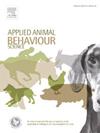Escape patterns of companion parrots kept in Brazilian Households
IF 2
2区 农林科学
Q1 AGRICULTURE, DAIRY & ANIMAL SCIENCE
引用次数: 0
Abstract
Uncontrolled escapes of pet psittacine birds present significant risks to individual welfare, public health, and local ecosystems. In Brazil, a country with a strong cultural tradition of parrot keeping, such events are frequent and often poorly managed. This study aimed to describe the dynamics of escape, assess preventive strategies, and evaluate recovery efforts following escape events. An online questionnaire collected data from 865 respondents, yielding 1053 individual bird records. A high escape incidence was reported (63.6 %), with most events occurring indoors, often due to open or unscreened windows. Although 67.4 % of birds had undergone wing clipping at some point, 70.6 % of those that escaped had fully regrown feathers at the time of the event. Birds with clipped wings exhibited a significantly higher escape probability (OR = 7.60, 95 % CI [3.33, 18.37]), possibly due to reduced caregiver vigilance. None of the prevention strategies such as window netting or enclosure confinement were fully effective, and escape rates remained high even in households that reported combined efforts. A total of 57.2 % of escaped birds were recovered, most within 12 h. Recovery was more likely when owners engaged in active search methods, while wing clipping and low effort were associated with delayed retrieval. Thirteen percent of recovered birds were found ill, injured, or died shortly after,reinforcing the need to replace restrictive practices with ethical, behaviorally sound alternatives. These findings highlight the urgency of improving husbandry standards, promoting caregiver education, and adopting science-based, welfare-centered strategies for the management of companion psittacines.
巴西家庭中同伴鹦鹉的逃跑模式
宠物鹦鹉不受控制的逃逸给个体福利、公共卫生和当地生态系统带来了重大风险。在巴西,一个有着强大的鹦鹉饲养文化传统的国家,这样的事件经常发生,而且往往管理不善。本研究旨在描述逃跑的动态,评估预防策略,并评估逃跑事件后的恢复努力。一份在线调查问卷收集了865名受访者的数据,产生了1053只鸟类的记录。据报道,高逃逸率(63.6 %),大多数事件发生在室内,通常是由于打开或未遮挡的窗户。尽管67.4 %的鸟类在某一时刻经历了翅膀剪断,但70.6 %的逃脱者在事件发生时羽毛完全再生。剪断翅膀的鸟类有更高的逃跑概率(OR = 7.60, 95 % CI[3.33, 18.37]),可能是由于看护者的警惕性降低。没有一种预防策略,如窗网或围栏限制是完全有效的,即使在报告联合努力的家庭中,逃脱率仍然很高。逃亡鸟的回收率为57.2% %,大部分在12 h内被捕获。当主人使用积极的搜索方法时,恢复的可能性更大,而剪翼和低努力与延迟检索有关。13%的恢复后的鸟类被发现生病、受伤或不久后死亡,这加强了用合乎道德、行为合理的替代方案取代限制性做法的必要性。这些发现强调了提高饲养标准、促进照料者教育以及采用以科学为基础、以福利为中心的策略来管理同伴鹦鹉的紧迫性。
本文章由计算机程序翻译,如有差异,请以英文原文为准。
求助全文
约1分钟内获得全文
求助全文
来源期刊

Applied Animal Behaviour Science
农林科学-行为科学
CiteScore
4.40
自引率
21.70%
发文量
191
审稿时长
18.1 weeks
期刊介绍:
This journal publishes relevant information on the behaviour of domesticated and utilized animals.
Topics covered include:
-Behaviour of farm, zoo and laboratory animals in relation to animal management and welfare
-Behaviour of companion animals in relation to behavioural problems, for example, in relation to the training of dogs for different purposes, in relation to behavioural problems
-Studies of the behaviour of wild animals when these studies are relevant from an applied perspective, for example in relation to wildlife management, pest management or nature conservation
-Methodological studies within relevant fields
The principal subjects are farm, companion and laboratory animals, including, of course, poultry. The journal also deals with the following animal subjects:
-Those involved in any farming system, e.g. deer, rabbits and fur-bearing animals
-Those in ANY form of confinement, e.g. zoos, safari parks and other forms of display
-Feral animals, and any animal species which impinge on farming operations, e.g. as causes of loss or damage
-Species used for hunting, recreation etc. may also be considered as acceptable subjects in some instances
-Laboratory animals, if the material relates to their behavioural requirements
 求助内容:
求助内容: 应助结果提醒方式:
应助结果提醒方式:


